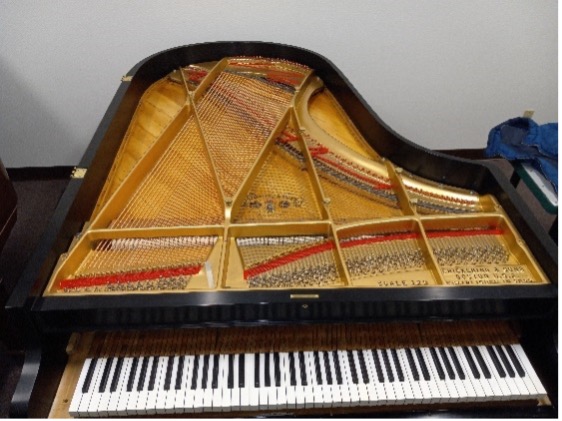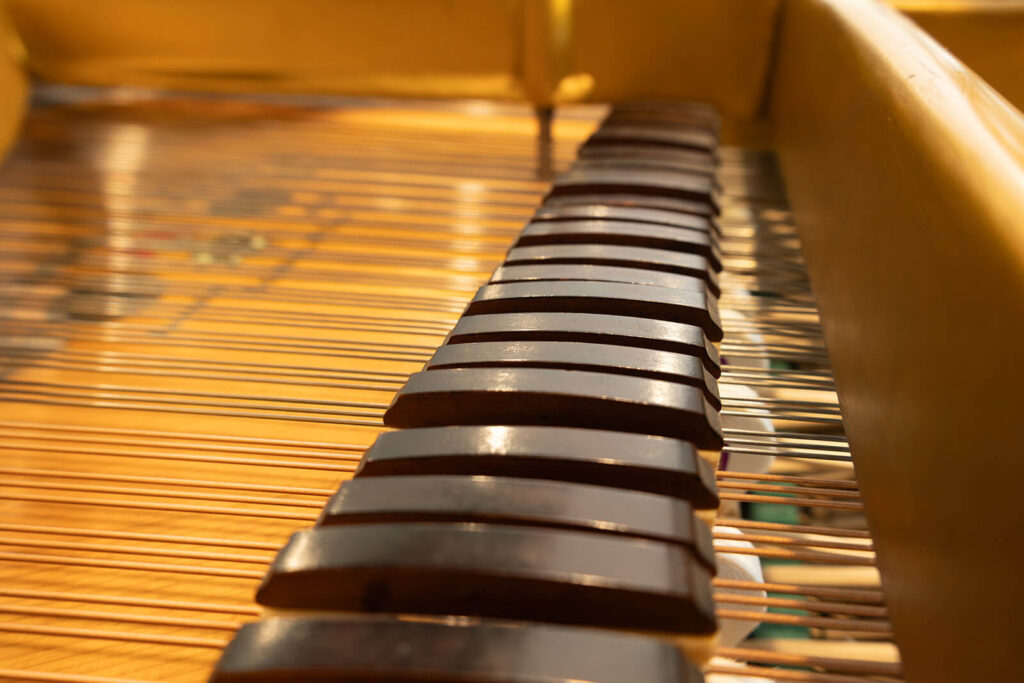History
Early History
The earliest stringed keyboard instruments, like the clavichord and harpsichord, can be traced to the early 1400s. It was not until about 1700 that the first piano appeared, invented in Italy by Bartolomeo Cristofori. When Jonas Chickering built his own first piano in the early years of the 1800s, what we think of as the modern version of that instrument had yet to be designed or constructed.
At that time, pianos were framed entirely of wood, without a full iron frame to absorb the stress of highly tensioned strings. The range of notes on pianos from the 1820s was also only six octaves, at most, and the tone was relatively soft and somewhat veiled. It took another fifty or so years for the piano to fully evolve, and although many manufacturers played a role in that process, Chickering was a major contributor. Jonas Chickering himself revolutionized the instrument by developing and utilizing the use of iron framing. Building on ideas from an 1825 patent by fellow Boston piano maker Alpheus Babcock, Chickering received his own patent for a one-piece cast-iron frame for a square piano in 1840 and another for an iron frame for grand pianos in 1843, allowing for much higher string tension.
In 1823, Jonas Chickering was invited to partner with Englishman James Stewart to form Stewart & Chickering, starting what would become one of the longest lasting, most successful, and most innovative piano firms in America. Stewart returned to London in 1827, but three years later Chickering secured financial backing from John Mackay. Mackay was a “silent partner” at first (his name did not appear on the company’s instruments), but in 1839 the firm became Chickering & Mackays when John’s son William joined the company. As a sea captain, Mackay was able to import large supplies of beautifully-grained rosewood from South America to veneer the company’s instruments and to facilitate exporting the company’s finished products to Europe and elsewhere. The Chickering firm quickly became a top supplier of pianos internationally.
Jonas Chickering had three sons—Thomas, Frank, and George—all three of whom took an active role in the business. Upon the death of Jonas in 1853, Thomas took over the company, renamed it Chickering & Sons, and continued transforming it into America’s largest and most prestigious piano maker. Between 1823 and 1890, designers and craftsmen working at Chickering created over one hundred different models of pianos, continuously changing and refining their product in pursuit of the perfect musical instrument.
The Golden Age (1890 – 1908)
By 1890, the modern piano had finally emerged and Chickering & Sons perfected the tone they wanted, a tone commonly referred to as the American sound. To achieve that sound, Chickering engineers developed the Yacht-Tail grand piano design, featuring a boxy case and a wide soundboard, similar in appearance to pianos made in Vienna. Over the next ten years, the Chickering factory produced more than two thousand of these Yacht-tail pianos.
As the 20th century began, the Yacht-Tail evolved into the Continuous Bent-Rim grand piano designs. That change happened more for cosmetic reasons than for tonal improvement. American consumers wanted sleeker, more modern looking pianos and Chickering’s Continuous Bent-Rim design met that demand.

Many music-loving homes had not been able to accommodate a grand piano, either because of size limitations or budget constraints, so upright pianos dominated the home market with their smaller footprint and lower cost. In 1901, Chickering changed all that. The Chickering engineers created the Anderson Plate, a minimalist iron plate that exposed more of the soundboard and allowed a smaller piano to make a bigger sound. With this invention, Chickering launched an entirely new line of smaller grand pianos for the home market, commonly called “Baby” grands. These small pianos quickly became some of the best-selling musical instruments of the 20th century.

The Golden Age also featured cabinet styles renowned for their graceful lines. Pianos before 1890 tended to be heavily ornamented in a Rococo style while pianos after 1908 tended to be unornamented. Pianos from the period 1890 to 1908 had an understated elegance, which many other manufacturers of that era imitated. These elegant cabinets are still admired today.

There was another Chickering company during this period named Chickering Brothers. Clifford Chickering, a distant relative of Jonas Chickering, opened the company in Chicago in 1892, and from the start, the two companies’ identities got confused. As a result, Chickering Brothers and Chickering and Sons became locked in a lawsuit for years. Information on this website pertains to Chickering and Sons pianos only. Chickering Brothers marketed its pianos under the Acoustigrand and Capacoustic labels, and listed Chicago on its decals.
The Ampico Years (1908-1932)
Chickering & Sons had financial difficulties in the early 20th century, but they were not alone. Other notable piano manufacturers like Knabe, Marshall & Wendell, and Mason & Hamlin were also struggling. Executives from these companies agreed to a merger and thus in 1908, the American Piano Company, or Ampico, was born.
The Chickering piano models created during the Golden Age were phased out over a 10-year period, and replaced with new ones. However, Chickering and Sons’ reputation continued to grow because of the popularity of its baby grands.

The 20th century gave birth to many other entertainment options. Radios and phonographs replaced live music at home and motion picture theaters enticed people to seek entertainment elsewhere. Because of these developments, the demand for pianos started to slow down, putting financial pressure on all piano makers. Then, in 1929, the stock market crashed and the Great Depression began. The piano business got hit especially hard.
The Aeolian Years (1932-1985)
Ampico and Aeolian merged in 1932 at the height of the depression, and the new company focused on manufacturing efficiencies and cost cutting to survive. Management closed factories, eliminated brands, and discontinued models. The Chickering and Sons name survived, but concert and semi-concert grand pianos were phased out. The Chickering name became associated with smaller, less expensive grand pianos (“baby grands”) and small uprights (“console pianos”).
Recent History (1985 – Present)
Wultizer acquired Aeolian in 1985 and production of Chickering pianos paused for a few years. Then, in 1988, Baldwin acquired Wultizer and production started up again. Baldwin used some of its own standard designs on its Chickering and Sons pianos. However, in 1995, Baldwin decided to retire the Chickering name entirely and production of Chickering pianos came to an end.
Gibson Music (formerly Gibson Guitar), bought Baldwin in 2001. Baldwin continues to own the Chickering & Sons brand but for now, the company is not marketing products under that name.
The Future
It’s unknown whether Gibson Music will revive the Chickering brand anytime soon. There is, however, one hopeful sign. Mason & Hamlin pianos, also known to have the American sound, are back in production. With hope that everything old becomes new again, there is cautious optimism that Chickering & Sons may rise once more.
